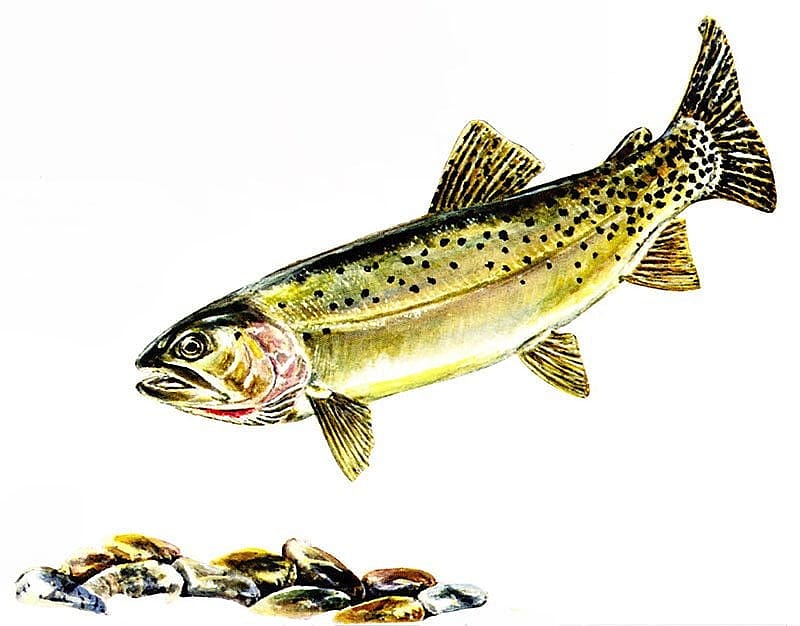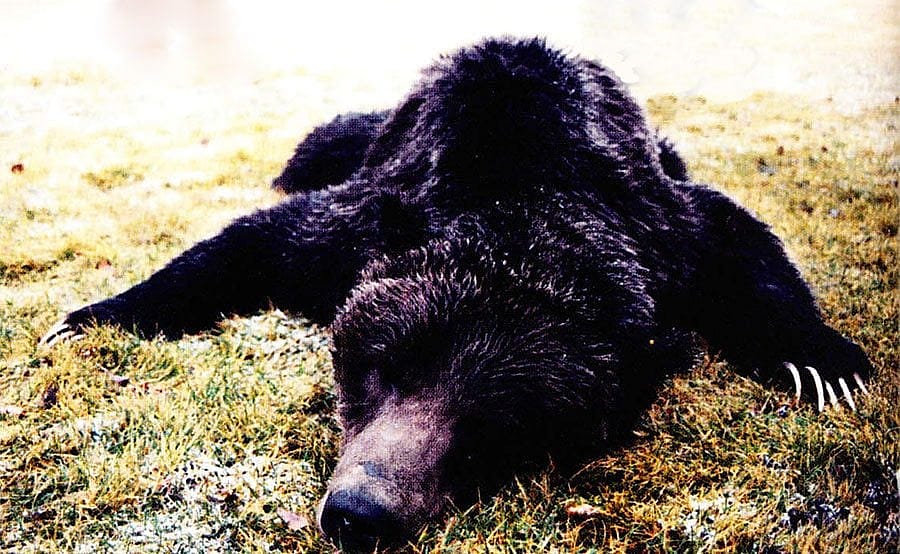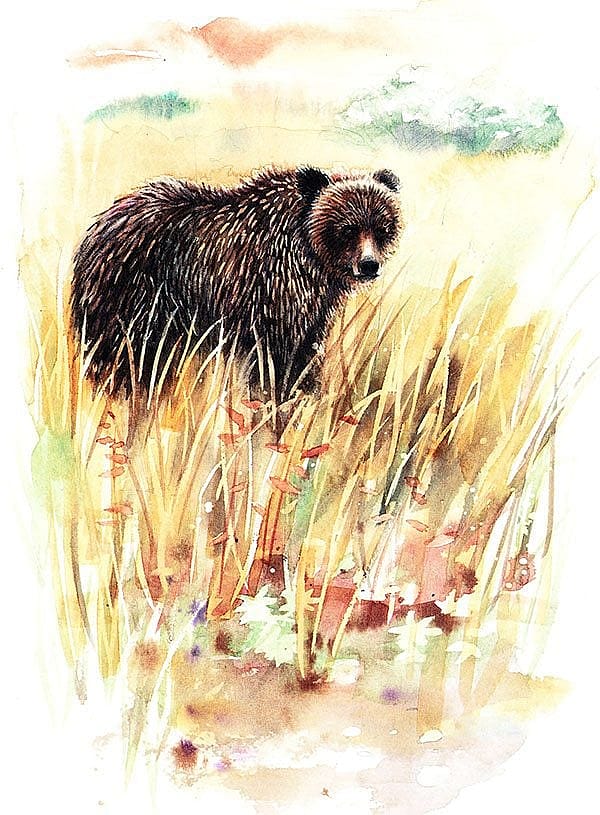
Bear-ly Making It – Points West Online
Originally published in Points West in Spring 2002
Bear-ly Making It: Can Homo Sapiens and Ursus Arctos Horribilis Make History and Coexist?
Ed. note: More than thirteen years later, grizzly bears and their status continue to evoke debate.

By Valarie Hamm
Former Intern, Draper Natural History Museum
“Maybe we should keep the engine running,” says my friend Rick, “in case we have to make a quick getaway.”
We peer through the foggy windshield half-hoping to see the outline of a grizzly bear prowling in the lingering shadows. But the only movement is that of a waking rooster in the pen beside our parked truck. He cocks his head to one side in the breaking daylight and begins to crow.
We have arrived early, even earlier than the game wardens, and we are hesitant to move deeper into the ranch. But soon the sun reveals a green government truck rolling down the lane, and we slowly follow it to an open field surrounded by cabins. In the middle of the grass sits a bear trap, and it is occupied…
Ursus arctos horribilis—the grizzly’s Latin name sounds foreboding. And the sight of a grizzly bear standing on his hind legs at seven feet tall and 600 pounds appears “horribilis” indeed (although in truth, a standing grizzly is simply a curious grizzly).
One of the largest land mammals in North America, grizzly (or brown) bears once lived as far south as Mexico and as far East as the mid-plains. But times have changed. The vast landscapes that so appealed to bears also appealed to settlers hungry for land and opportunity, and grizzlies now occupy only 2 percent of their original home range in the lower 48 states.
“In the early part of the twentieth century, there were well-organized, even government sponsored campaigns to eradicate the large predators that threatened the well-being of the livestock industries,” said Mark Bruscino, a bear management officer for the Wyoming Game and Fish Department. “A lot of bears died at the hands of man.”

Bears can live in a variety of habitats, as long as there’s enough space—female grizzlies typically need a home range of 50 to 300 square miles; males, 200 to 500. Today, grizzlies reside primarily in mountainous habitats in the lower 48, but historically they roamed riparian areas in the plains as well. And while such habitat was once in abundance, development throughout the last century caused a significant decline in available land. Rural and recreational development, road building, energy and mineral exploration…all these activities moved into areas traditionally occupied by grizzlies.
By the 1970s, grizzly numbers and densities reached a critical low. Extinction appeared imminent, and biologists worried they might not only lose the grizzly but the information they derived from the bear as an “umbrella species.” (Umbrella species, so named because their habitats encompass the habitats of many other species, help biologists assess the health of entire ecosystems.)
“[The grizzly bear] is a species whose habitat needs are so great that when you protect the viable populations, you are protecting the whole tapestry of the Rocky Mountains,” said Chuck Neal, former Bureau of Land Management rangeland specialist. “We would all be poorer if the grizzly were to disappear.”

In 1975, the United States Fish and Wildlife Service (USFWS) afforded grizzlies federal protection as a “threatened species” under the Endangered Species Act. The Greater Yellowstone Ecosystem, which includes Yellowstone National Park and surrounding regions in Idaho, Montana and Wyoming, was designated a target recovery zone. Twenty-five years later, the USFWS claims the grizzly population increased from a 1970s low of 200 to a current 400 – 600 and continues to grow 2 – 4 percent annually. Yet as both human and bear populations have increased, so too has conflict. Can man and grizzly share land and live side-by-side? The answer is still in the making.
From a safe distance, Rick and I watch as the Game Wardens tranquilize the bear and remove him from the trap. Soon we join them on the grass and I am amazed at the bear’s tranquility. His claws are long and sharp, but he snores softly, small bubbles blowing gently from his nose like a resting baby.
Two days earlier, this sleeping beauty (Number 153, according to his lip tattoo) broke into a Seven D Ranch cabin kitchen. He’d visited Wyoming’s Sunlight Basin 15 years before and poked through the ranch’s burn pit, but this time he took advantage of a quiet night to rummage through the refrigerator. As the ranch staff snacked on birthday cake in town, Number 153 dined on pork fat, strawberry jam, eggs, lunch meat, Hershey’s syrup…then he took a package of bacon to go.
Most grizzlies can smell a human a mile away and approach unnoticed, but bears generally avoid human contact. Their primary goal is to eat, reproduce, and seek shelter and safety—not to attack hikers or campers.
“I think there’s a fear of bears that’s not very realistic,” said Kerry Gunther, Yellowstone National Park’s bear management biologist. “We’ve had more people murdered [in the park] than killed by bears.”
Yellowstone National Park (YNP) has had a long-standing relationship with grizzly bears. Prior to the 1970s, grizzlies were allowed free access to park garbage dump sites; park officials even set up bleachers for spectators. When the dumps finally closed, officials spent the next three years relocating and removing more than 30 bears accustomed to eating a garbage diet. Now the park removes a bear infrequently, about once every three to five years.
“Yellowstone National Park is about a third of the recovery zone,” said Gunther, “but we account for less than ten percent of the human-bear conflicts.” Gunther credits the park’s stringent sanitation programs for the success—backcountry camps have food storage poles, park garbage is picked up twice daily and all sewage treatment plants are fenced. But for those bear management officials working outside the park and among settled areas, coping with increasing numbers of bears is proving more difficult.

“Bear-proof dumpsters in rural subdivisions are a good thing, but it’s still not addressing the entire issue—that bears and humans don’t live well together,” explained Bruscino. In 2001 alone, there were 175 reported human-grizzly conflicts in the Wyoming portion of the Greater Yellowstone Ecosystem. (A human-grizzly conflict incident can range in definition from property damage to food rewards to cattle damage or human injury). Human-grizzly conflicts often result in the trapping, tagging and relocation of a nuisance bear. Those animals that injure humans, appear especially threatening or return repeatedly after relocation are sent to zoos or euthanized—”removed.”
“I truly believe they don’t really want to interact with people,” said Bruscino. “I think they view humans as other bears—something they’d rather not contend with.” Yet in increasingly cramped quarters, interaction is inevitable. And since bears are smart enough to know that sheep and cows make a bigger meal than other lower-calorie sources, like berries or roots, interaction between grizzlies and livestock is becoming more common.
“The bear himself is trying to earn a living but at times his trying to earn a living conflicts with my trying to earn a living,” said Albert Sommers, a rancher in Pinedale, Wyoming. As president of the Upper Green River Cattlemen Association, Sommers has noticed an increase in the number of bear attacks on his members’ livestock. Association members have also seen more grizzlies on their Forest Service allotments, explained Sommers, when “five or six years ago, it was really uncommon.”
Sommers’ own dead or missing calf losses skyrocketed during the 1990s, rising from an average in 1990 – 1994 of 1.6 percent to a high of 5.3 percent in 1999 before finally receding to a more manageable 2.2 percent. Ranchers receive compensation for grizzly depredation of livestock, but Sommers says it isn’t enough if the mortality rate is too high. Still, Sommers believes bears and ranchers can co-exist “as long as you remove and relocate problem bears and as long as you’re not relocating them somewhere where they’ll become someone else’s problem.”
As bears spread beyond the recovery zone, and people move closer to the edges of YNP, the need for management actions increase. Unfortunately, bear management—from relocation, to removal, to killing to reparation for damages to livestock—is expensive and timely. And with an additional 23 incidents occurring each year in Western Wyoming, bear management officials are struggling to keep up.
“Right now we’re stretched to the max. There has been an increase in conflicts, not because we’re not doing a good job, but because there are more bears and more people,” said Bruscino. “Management of nuisance bears can be very expensive, which is something the public has to support.”
It is snowing, and my toes are chattering in my boots. We help the game wardens load the sleeping bear back into the trap. He is heavy—it takes four of us to get him loaded—and groans quietly when lifted. I am surprised he has not already awakened and thrashed about in fear and rage because he is captured, because his hunger overcame caution and the scent of a rotten deer leg lured him into a box with no exit.
I watch the truck and occupied trap rattle off down the lane. They don’t know what they’re going to do with him.
The growth of the grizzly population and an increasing need for management are now leading some to wonder if the time has come to remove the brown bear from the Endangered Species List.
“The grizzly bear isn’t endangered,” said Sommers. “There are lots of bears in Alaska, and the Yellowstone population has recovered.”
The USFWS, along with Montana, Wyoming and Idaho, is about to release a revised regional conservation strategy to be employed upon the grizzly’s possible delisting. Although still in draft form, the plan calls for limited hunting and would allow more state discretion in management decisions. Yet not everyone agrees that the bears are ready for delisting.

“If we are to achieve our goal of a self–sustaining, truly recovered grizzly bear population across the U.S. Northern Rockies, there must be a dramatic increase in occupied habitat,” wrote Neal in a May 2001 letter to Wyoming Game and Fish Commission. According to Neal, a larger bear population would ensure that the species could cope with various genetic, demographic, environmental and catastrophic uncertainties. Reintroducing bears to certain areas—like the Bitterroot Ecosystem in Montana and Idaho and unoccupied habitat south of Yellowstone Country—would create a broader gene pool and help bears reach a necessary minimum of 2000.
But in order to create such a gene pool, Neal says the remaining public lands must remain roadless. And if it comes to a choice between maintaining domestic livestock or providing habitat for native wildlife, domestic use has got to go.
“The public lands preeminent use must be for the native wildlife,” Neal said. But such an approach doesn’t sit well with ranchers like Sommers. Sommers’ family grazed cattle on public lands even before many of the current state and federal agencies were established. “Surely the bear was here before we were, but as long as we take care of the land, we have a right to exist there,” said Sommers. “And as far as I know, the National Forest is supposedly still managed under the multi-use concept.”
Regardless, delisting isn’t likely to happen too soon. The conservation plan must be completed and deemed adequate for continued grizzly survival. The plan’s authors also expect litigation from groups and individuals not satisfied with the decision to delist, litigation that could prolong any changes to current grizzly policy.
“The Game and Fish is absolutely committed to long term bear recovery,” said Bruscino. “How we accomplish that is a topic of debate.”
Yet despite all the controversy, a shared sense of appreciation and awe for the grizzlies remains untainted. Bears have intrigued explorers, tourists and scientists for hundreds of years, and there’s no sign that our fascination is now dwindling. Millions of Yellowstone tourists continue to visit the national park each year, many with the hope of spying a grizzly. Researchers are also investigating why and how bears avoid bone loss during long periods of hibernation. If they find the answer, osteoporosis may become a thing of the past.
But what is perhaps more important than scientific discoveries or a grizzly sighting in the national park, is what the bears tell us about mankind, says Gunther—and “everyone’s desire for their own five acres of paradise.”
I learned later that Number 153 was too skinny, too hungry…that he was so old and his teeth so ground down that he was struggling, unsuccessfully, to obtain the calories necessary for a long winter hibernation. Where there should have been six inches of fat there was less than one. He was starving and would have returned again and again to the ranch.
“Given the fact that he had nowhere to go but down, we decided to euthanize him,” Bruscino told me. “It’s the hardest part of my job, but it’s also a necessary management action.”
So the bear rests, I tell myself. At least his last supper was a good one.
About the author
Valarie Hamm is a freelance writer and photographer living in Cody, Wyoming. At the time of this article, she was an exhibits intern at the Draper Natural History Museum.
Written By
Nancy McClure
Nancy now does Grants & Foundations Relations for the Center of the West's Development Department, but was formerly the Content Producer for the Center's Public Relations Department, where her work included writing and updating website content, publicizing events, copy editing, working with images, and producing the e-newsletter Western Wire. Her current job is seeking and applying for funding from government grants and private foundations. In her spare time, Nancy enjoys photography, reading, flower gardening, and playing the flute.












